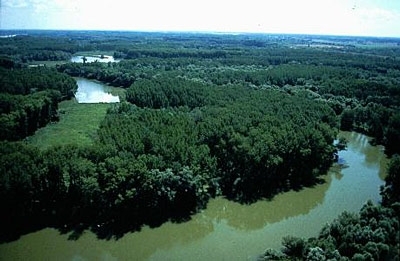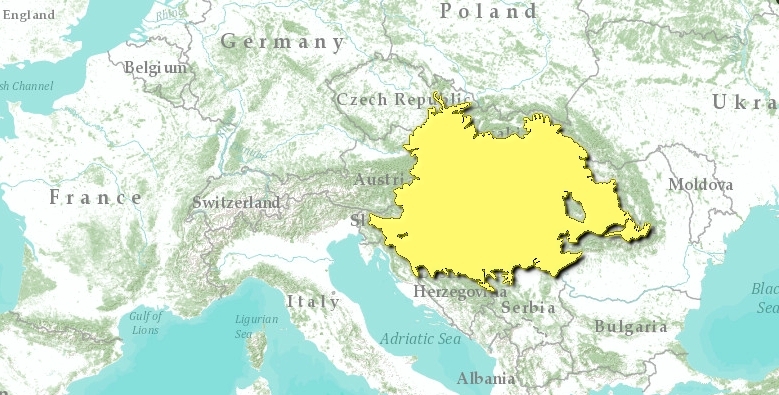Template:Pannonian mixed forests
Contents
Pannonian mixed forests
There is no vertebrate endemism in the Pannonian mixed forests due to the similarity of adjacent ecoregion habitats; however, there are numerous threatened vertebrate species within the ecoregion, particularly of native mammals.
Location and general description
This ecoregion consists of a topographic depression surrounded by the Carpathian Mountains, Alps, and Dinaric Mountains. Avifauna diversity is high; moreover, there are fifty Important Bird Areas in the Pannonian mixed forests. Lake Neusiedel with Seewinkel National Park, and other important wetlands are renowned for their birdlife (Heath and Evans 2000). Resident mammals are somewhat widespread throughout Europ, including the range of the Wolf (Canis lupus). Recreation and tourism, persecution, unsustainable exploitation, land development and habitat fragmentation, agriculture development, and disturbance of wildlife, are other significant threats (Heath & Evans 2000). There are a number of natural parks in this ecoregion, but much of the natural habitat has been lost to agriculture.
Biodiversity features
There are a total of 377 resident vertebrates that have been recorded in the Pannonian mixed forests; however, a complete count of migratory birds and other occasional sightings swells this record to over 500 taxa. Moreover, none of these taxa are endemic, due to the free migration of species among the Eurasian ecoregions, owing to ample large scale biological corridors in prehistoric times and to the landscape permeability of these ecoregions. Dominant canopy trees of the ecoregion include oak, poplar, beech and hornbeam.
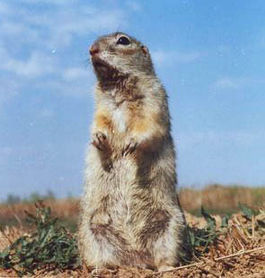 The spotted suslik. Source: V.A.Lobkov The native non-endemic mammals here are: the Near Threatened Alpine shrew (Sorex alpinus), the Near Threatened Bechstein's bat (Myotis bechsteinii), the Vulnerable European ground squirrel (Spermophilus citellus), the Endangered European mink (Mustela lutreola), the Near Threatened European otter (Lutra lutra), the Near Threatened European rabbit (Oryctolagus cuniculus), the chiefly nocturnal Near Threatened Grden dormouse (Eliomys quercinus), the Near Threatened giant noctule (Nyctalus lasiopterus), the Vulnerable long-fingered bat (Myotis capaccinii), the Vulnerable Martino's snow vole (Dinaromys bogdanovi), the Near Threatened Horseshoe bat (Rhinolophus euryale), the Vulnerable Mehely's horseshoe bat (Rhinolophus mehelyi), the Near Threatened pond bat (Myotis dasycneme), the Near Threatened Schreiber's long-fingered bat (Minopterus schreibersii), the Near Threatened Spotted suslik (Spermophilus suslicus) and the Near Threatened Western barbatelle (Barbastella barbastellus).
The spotted suslik. Source: V.A.Lobkov The native non-endemic mammals here are: the Near Threatened Alpine shrew (Sorex alpinus), the Near Threatened Bechstein's bat (Myotis bechsteinii), the Vulnerable European ground squirrel (Spermophilus citellus), the Endangered European mink (Mustela lutreola), the Near Threatened European otter (Lutra lutra), the Near Threatened European rabbit (Oryctolagus cuniculus), the chiefly nocturnal Near Threatened Grden dormouse (Eliomys quercinus), the Near Threatened giant noctule (Nyctalus lasiopterus), the Vulnerable long-fingered bat (Myotis capaccinii), the Vulnerable Martino's snow vole (Dinaromys bogdanovi), the Near Threatened Horseshoe bat (Rhinolophus euryale), the Vulnerable Mehely's horseshoe bat (Rhinolophus mehelyi), the Near Threatened pond bat (Myotis dasycneme), the Near Threatened Schreiber's long-fingered bat (Minopterus schreibersii), the Near Threatened Spotted suslik (Spermophilus suslicus) and the Near Threatened Western barbatelle (Barbastella barbastellus).
The native, but non-endemic threatened amphibians of the Pannonian mixed forests are represented by the sole species, the Near Threatened Danube newt (Triturus dobrogicus).
Pannonian mixed forests exhibit the following special status reptiles: the Lower Risk European pond turtle (Emys orbicularis), the Lower Risk Grass snake (Natrix natrix), the Near Threatened Hermann's tortoise (Testudo hermanni) and the Vulnerable Orsini's viper (Vipera ursini).
The ecoregion supports the following native non-endemic avian species: the Near Threatened European roller (Coracias garrulus), the Near Threatened Ferruginous pochard (Aythya nyroca), the Vulnerable Great bustard (Otis tarda), the Vulnerable Greater spotted eagle (Aquila clanga), the Vulnerable Imperial eagle (Aquila heliaca), the Vulnerable Lesser kestrel (Falco naumanni), the Vulnerable Lesser white-fronted goose (Anser erythropus), the Near Threatened Red kite (Milvus milvus), the Near Threatened Red-footed falcon (Falco vespertinus) and the Vulnerable Saker falco (Falco cherrug).
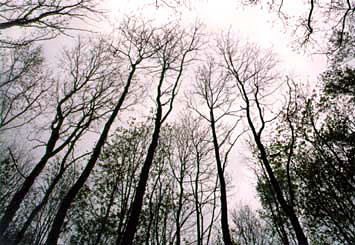 Otrokovice, Czech Republic. Photograph by The GLOBE Program
Otrokovice, Czech Republic. Photograph by The GLOBE Program
Protected areas
There are a number of protected areas within the Pannonian mixed forests ecoregion. Some of these are areas that differ from the pristine forested ecological landscape such as the Hungarian Hortobágy National Park, which is actually a large grassland, mostly formed by the influence of humans.
Hortobágy National Park
This UNESCO World Heritage Site is Europe's largest grassland preserve at around 800 square kilometres, although it was actually formed by late Pleistocene course change in the Tizna River, creating enhanced soil alkalinity combined with accelerated grazing of mastodons and wild horses. The final transformation of a forest was carried out by medieval deforestation carried out by man, followed by heavy grazing of domestic livestock.
Danube-Drava National Park
This protected area of about 490 square kilometres is positioned in the southwest of Hungary along the floodplains of the Danube River and Drava River. Approximately forty percent of the National Park is actually a RAMSAR wetland, replete with large numbers of resident and migratory birds.
Kiskunság National Park
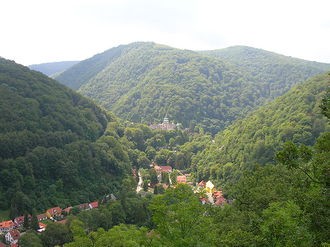 Valley of Lillafüred from Szelete cave, Bukk Mountains.
Valley of Lillafüred from Szelete cave, Bukk Mountains. Bükk National Park
This forested area is situated in the far north of Hungary not far from the border with Poland. The underlying geology features limestone formations, including interesting karst caves inhabited by paleolithic man.
Körös-Maros National Park
This protected area is in the extreme southeast of Hungary within the Southern Great Plain, along the Romanian borderland. It has a number of riparian and wetland components such as the Kis-Sárrét swamp and Lake Fehér. The Körös-Maros National Park includes a major area specifically for protection of the Vulnerable Great bustard.
Triglav National Park
This property of some 880 square kilometres, is within the Julian Alps of northern Slovenia. It is known for its myriad lakes of glacial origin, numerous waterfalls and special occurrences of medicinal plants. The ridgeline within Triglav demarcates two distinct watersheds: the Soča and the Sava, flowing oppositely to the Adriatic and Black Seas,
Plitvice Lakes National Park
Besides the enormous diversity of waterfalls and scenery, Plitvice Lakes in Croatia is known for an incredible diversity of nocturnal moths, occurrence of Brown bear., Wolves and presence of 55 different orchid taxa. A special area of the Park is the northwest corner, where a virgin forest of Beech and Fir boasts specimens over 700 years old.
Other protected areas include Logarska Dolina in northern Slovenia; the Škocjan Caves Regional Park in Slovenia, a karstic limestone area which is known for a number of rare and endangered species of bats and birds.
Prehistory
The Pannonian mixed forests were a very early European venue for hominids, beginning with extensive neanderthal settlement, expecially in the river valleys and karstic caves such as the Karpina area of far northern Croatia. In northwestern Slovenia, the Potak Cave has yielded important modern Cro Magnon man prehistoric discoveries circa 33,000 BC, including a bone flute thought to be the oldest musical instrument ever found. In the era of Homo sapiens, some of the earliest sedentary agriculture of Europe was found in the manifestation of the Starčevo culture, which was the chief cultural horizon across the ecoregion approximately 5000 BC.
Current status
The Pannonian mixed forests has a conservation status of Critical/Endangered. The World Wildlife Fund has not classified this ecoregion to G200 status, meaning it is not considered as a highest priority for worldwide conservation.
Justification of ecoregion delineation
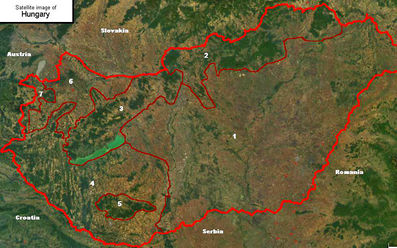 Substantial portion of the Pannonian mixed forests, centered on Hungary. Source: NASA This ecoregion is equivalent to the DMEER (2000) unit of the same name. The boundaries of this unit are primarily a product of the DMEER delineation process, which were then modified during discussions between WWF, DMEER, and Dr. Udo Bohn. The ecoregion is based on the complex of vegetation in the Pannonian basin. This complex includes subcontinental thermophilous (mixed) pedunculate oak and sessile oak forests, sub-Mediterranean subcontinental thermophilous bitter oak forests, as well as mixed forests, mixed oak-hornbeam forests, sub-Mediterranean-subcontinental lowland to montane herb-grass steppes, and azonal floodplain vegetation (Bohn et al. 2000). Outlying areas of downy oak forests, mixed oak-hornbeam forests, and beech and mixed beech forests that were part of the early DMEER unit were split off and merged with surrounding ecoregions.
Substantial portion of the Pannonian mixed forests, centered on Hungary. Source: NASA This ecoregion is equivalent to the DMEER (2000) unit of the same name. The boundaries of this unit are primarily a product of the DMEER delineation process, which were then modified during discussions between WWF, DMEER, and Dr. Udo Bohn. The ecoregion is based on the complex of vegetation in the Pannonian basin. This complex includes subcontinental thermophilous (mixed) pedunculate oak and sessile oak forests, sub-Mediterranean subcontinental thermophilous bitter oak forests, as well as mixed forests, mixed oak-hornbeam forests, sub-Mediterranean-subcontinental lowland to montane herb-grass steppes, and azonal floodplain vegetation (Bohn et al. 2000). Outlying areas of downy oak forests, mixed oak-hornbeam forests, and beech and mixed beech forests that were part of the early DMEER unit were split off and merged with surrounding ecoregions.
References
- Udo Bohn, Gisela Gollub, and Christoph Hettwer. 2000. Reduced general map of the natural vegetation of Europe. 1:10 million. Bonn-Bad Godesberg 2000.
- John Chapman. 2000. Fragmentation in Archaeology: People, Places, and Broken Objects. London: Routledge. ISBN978-0-415-15803-9
- S.D.Davis, V.H. Heywood and A.C. Hamilton. 1994. Centers of plant diversity. Vol. 1: Europe, Africa, Southwest Asia and Middle East. WWF and IUCN, Washington DC.
- Digital Map of European Ecological Regions (DMEER), Version 2000/05
- Vito Hazler. 2010. Protection and Presentation of Cultural Heritage in Triglav National Park and in Regional and Landscape Parks in Slovenia. (PDF). Etnološka istraživanja/Ethnological Researches. 15.
- M.F.Heath and M.I.Evans, editors. 2000. Important bird areas in Europe: Priority sites for conservation. 2 vols. BirdLife International, Cambridge, UK.
- H.Heinzel, R. Fitter, and J. Parslow. 1977. Pareys Vogelbuch - Alle Vögel Europas, Nordafrikas und des mittleren Ostens. Aufl. Verl. P. Parey, Hamburg, Berlin.
- Hortobágy National Park, The Hungarian Puszta" (PDF). Nomination file for inscription of the Hortobágy National Park to the World Heritage List. Ministry for Environment and Regional Policy, Republic of Hungary. 1999.
- IUCN 2000: The Global Redlist of Species, of the International Union for the Conservation of Nature. URL:
- P.Ozenda. 1994. Végétation du Continent Européen. Delachaux et Niestlé, Lausanne, Switzerland.
- Stanners, D., and P. Bourdeau, editors. 1995. Europe's environment: The Dobris assessment. European Environment Agency, Copenhagen.
- Wheatley, N. 2000. Where to watch birds in Europe and Russia. Princeton University Press, Princeton, New Jersey.
